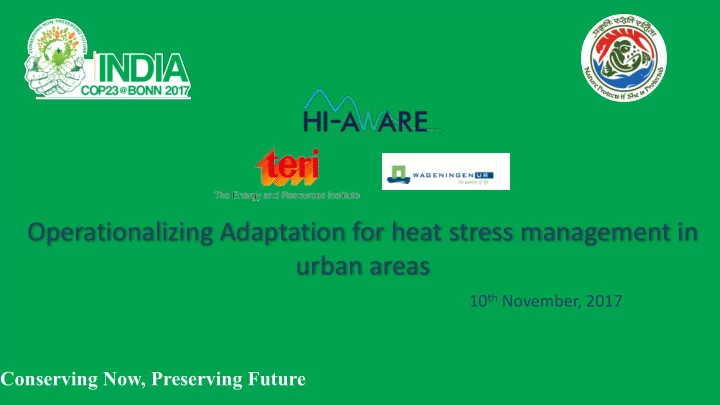

Operationalizing Adaptation for heat stress management in urban areas 10 th November, 2017 Conserving Now, Preserving Future
What is HI-AWARE ? Five year research project under CARIAA Focus on South-Asia – (Hindu-Kush Himalayan Region) Conserving Now, Preserving Future
Why the HKH region? - All of Asia likely to warm during this century, with lock-in of 2 o C global average temp rise. - Warming in HKH mountains likely to be around 3-4 o C by end of century, well above global average. - Winter precipitation is projected to increase in Tibetan Plateau whereas summer monsoon is generally likely to increase in South Asia. - Extreme rainfall as well as drought events are likely to increase. Conserving Now, Preserving Future
Enhance the adaptive capacities and climate resilience of the vulnerable in the mountains and plains of the river basins of the Hindu Kush Himalaya (HKH) region, through the development of robust evidence to inform people-centred and gender sensitive climate change adaptation policies and practices. Conserving Now, Preserving Future
Pilots/experimentations - HI-AWARE is developing robust evidence on adaptation innovations, measures and options to inform people-centred and gender sensitive adaptation policies and practices - Under the Knowledge Generation Work Package, HI-AWARE is also testing adaptation measures - These issue specific interventions in the Indus , Ganga, Gandaki and Teesta river basins are aimed at evaluating the viability and effectiveness of the intervention - As part of this TERI is involved in two experimentation to test adaptation interventions; one in New Delhi – on indoor heat stress management, and the other in Rudraprayag (Uttarakhand) - Weather appropriate sustainable agriculture practices Conserving Now, Preserving Future
Conserving Now, Preserving Future
How did we go about with the study? - Multifold research design - Indoor loggers measuring temperatures (and humidity) every 10 minutes were installed in 63 households – April through October - Outdoor mobile measurement unit (car-top) was used to capture temperature and other vital weather parameters weekly to understand heat stress in the transect traversing through localities where the loggers were placed – April through September - Apart from this we have also installed an AWS in Vasant Kunj to understand the spatial temperature trends at a larger scale Conserving Now, Preserving Future
Conserving Now, Preserving Future
What did we learn? 35 o C and above observed in many instances during the night over the course of the six months (HI-AWARE findings) 29 o C in Delhi during night indoors (HI-AWARE findings) Advised sleeping temperature - ~ 18.5 o C (optimum temperature) and 26 o C (Indian Meteorological Department) Conserving Now, Preserving Future
What is happening? - A handful of actions witnessed across levels and jurisdictions - Being carried out by the state, city administration and most of them are at an individual level - Example of coordinated effort to address the issue of heat stress can be found in the Ahmedabad Heat Action Plan (HAP) - HI-AWARE is experimenting with a more structural/hard intervention aimed at alleviating indoor heat stress Conserving Now, Preserving Future
Testing modified roofs (ModRoofs – ReMaterials) as an adaptation measure for indoor heat exposure in low-income neighborhoods Conserving Now, Preserving Future
What are we doing? The Modified Roofs, or simply ModRoofs, is an innovative solution that: - is a modular roofing system (made out of agricultural and paper waste) for low-income neighbourhoods using corrugated cement/metal sheets - have a low thermal conductivity value, translating to reduced indoor temperatures - are easy to install, fire proof , movable and sustainable Targeting the least opportune and most vulnerable Conserving Now, Preserving Future
- Implementing in low-income suburb - Aim to understand the effectiveness of the roofing structure in reducing both day-time and night-time temperatures. - Indoor temperature loggers have been placed inside these houses to continuously monitor the temperature trends. - This is being contrasted with a control of 10 houses having corrugated cement sheet roofs to understand the overall effectiveness of the measure. Conserving Now, Preserving Future
Implications for Policy and Practice - Urban regions in India would only grow and sustain more lives and their livelihoods - Along with this, heat stress/heat waves would also see a rise due to current global emission pathways, exposing millions in India to the health implications - Climate proofing existing and future infrastructure is essential to mitigate some impacts from this rise - Innovation for climate proofing in low cost housing has strong links with existing macro urban policies, like Smart Cities and Housing for All schemes, and help mainstream heat stress management in urban areas Conserving Now, Preserving Future
Thanks @ COP23 For more information: www.hi-aware.org Contact: Ganesh Gorti, TERI Supported by: Ganesh.Gorti@teri.res.in Design elements: Debabrat Sukla, ICIMOD Conserving Now, Preserving Future
Recommend
More recommend